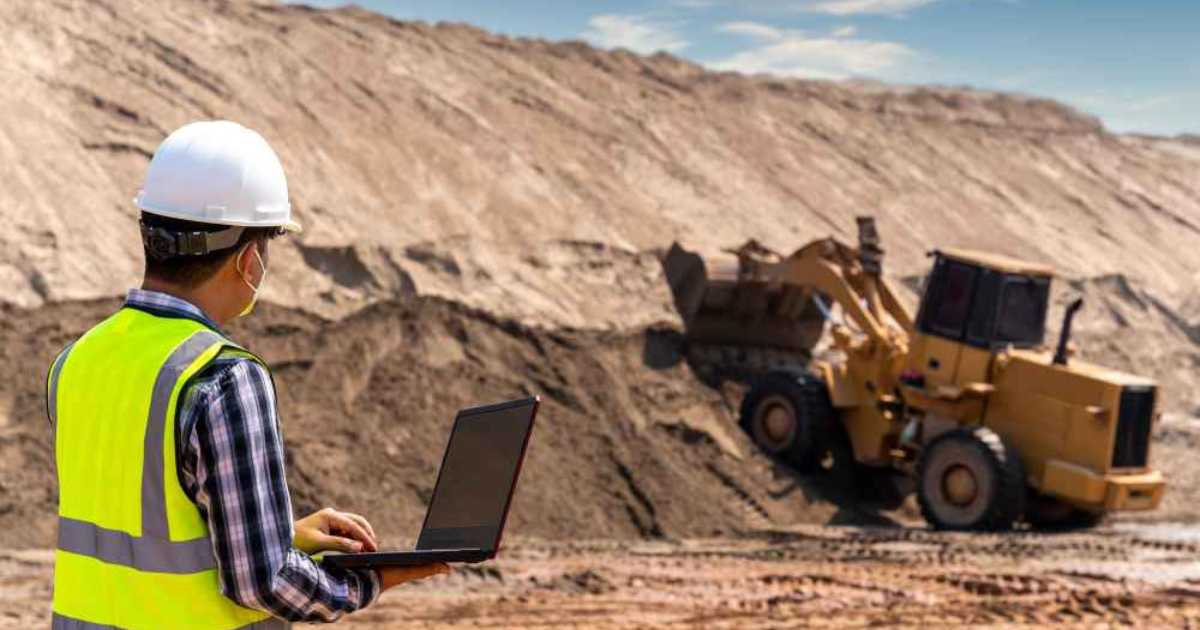What is ERP for the Mining Industry?
ERP for Mining Industry is sophisticated business management software that streamlines essential processes involved in the mining industry and facilitates seamless coordination between the human workforce, organizational assets, and resources. It encompasses diverse modules for managing mining operations and provides tools and functionalities specifically tailored to mining businesses.
ERP systems build a centralized repository of data across all business departments and provide data-driven analysis, reports, and solutions. It facilitates collective tracking of the movement of materials from the mine plant to the final customer, making the organization more agile as it quickly responds to changing market conditions, seasonal changes, and trends.
Overview of the Mining Industry
India is a mineral-rich country with a substantial reserve of iron ore, coal, chromite, and others. It is a major producer of an extensive range of minerals, including iron, gold, coal, zinc, lead, and uranium. The GDP from the Indian mining sector grew from Rs. 790.22 Billion to Rs. 981.04 Billion in the first quarter of 2023. The country is the 2nd largest producer of iron ore and the 8th largest producer of coal in the world.
There are several factors contributing to the growth of the Indian mining sector. The demand for minerals is strong both domestically and internationally. Private players are pouring money into the mining sector due to its high revenue potential. Moreover, the use of advanced technology such as remote sensing, the Internet of Things (IoT), and drones is bringing efficiency and reducing costs and hazards.
You May Also Like: ERP for Oil and Gas Industry
Challenges Faced by the Mining Industry
-
Environmental Concerns and Regulations
Mining activities can cause soil erosion, deforestation, and pollution. They can have negative environmental and climate change consequences that can endanger human and animal lives. As a result, the mining industry is highly regulated. It is under pressure to adopt sustainable practices for soil and water conservation, reduce waste, and minimize negative impacts on the environment.
-
Detrimental Effects on Workforce Health
Some mining companies in India do not provide protective gear, safety helmets, safety glasses, respiratory masks, and other critical instruments to mining workers. As a result, miners suffer from stress and fatigue, hearing issues, skin problems, and lung damage. They also suffer from long-term, serious chronic health problems. The toxic air and gases produced during mining activity can cause respiratory problems or cancer.
-
Accidents and Hazards
Mining is a dangerous activity with a higher fatality rate. Mining workers often get injured by heavy machinery or moving parts. They also come into contact with live wires and get electrocuted. Sometimes, the workers get trapped underground or suffer serious burns due to explosions caused by flammable gases in the underground. Miners can also come into contact with dangerous radioactive materials during the natural breakdown of uranium in soil and rock.
-
Land Acquisition Issues
Mining projects in India are often hindered due to land acquisition issues. Local communities often oppose mining activities for their negative environmental and health effects and hazards. Moreover, land acquisition is a challenging process in India due to complex laws, overlapping and multiple ownership issues, and other reasons. Delays in land acquisition can create uncertainty, hinder projects, and increase costs.
-
Transportation Challenges
The roads in India are of poor quality, congested, and lack maintenance and safety measures. Mining companies often face challenges transporting minerals to market due to a lack of proper roads and connectivity throughout the country, accidents, thefts, and other forms of disruption. Damages during transit can cause additional costs and reduced revenues. Companies need to build a comprehensive transportation management plan for better risk management.
Future Trends in the Mining Industry
-
Robots and Automation
Mining industries are using automated systems like robots to reduce dependence on human labor in dangerous and critical activities. They can collect soil samples and extract minerals with minimal environmental impact. Robots can carry out dangerous tasks with high precision, such as drilling holes with pinpoint accuracy at blasting locations. The use of robots also helps reduce costs, improve efficiency and accuracy, and perform tasks that are beyond human capabilities.
-
Digitization and Advanced Technology
Mining industries use sensors and IoT devices to track data on mine conditions, worker safety, and equipment performance. The use of big data analysis helps them uncover meaningful insights, make accurate predictions, and improve decision-making. They can use AR and VR technologies to stimulate mining operations, identify risks and hazards, and safeguard the safety of miners. Besides, data analysis can also help predict machine failure, take corrective measures, and reduce machine downtime. The lower the machine downtime, the higher the productivity.
-
Sustainability and the Green Economy
By integrating ERP for electronics manufacturing, mining companies can effectively manage the exploration and extraction of resources like lithium and cobalt, ensuring sustainable practices and ethical sourcing. This facilitates transparency in the supply chain, compliance with environmental regulations, and supports the transition towards a greener economy driven by the production of solar panels and electric vehicles.
Features of ERP for Mining Industry
-
Integration
ERP solution for mining industry integrates data from all business aspects. It saves employees from the hassle of entering the same data over and over, eliminating duplicate records and errors. Decision-makers can access key business data to get a better understanding of business operations and find areas for improvement. The best business management software brings operational efficiency and improves various aspects of the mining business, such as project management, asset management, supply chain management, financial management, and compliance.
-
Data Analysis
Data analysis involves collecting, storing, and analyzing data to find historical trends and patterns and accurately forecast future sales, revenues, and expenditures. Mining ERP software has Business Intelligence Tools and data analytical capabilities that provide useful insights into business data and make actionable decisions that reduce risks, minimize costs, improve profitability, and benefit the business in the long run.
-
Reporting and Dashboards
The best ERP for the mining industry provides Business Intelligence tools, also called BI tools. These tools play a vital role in data consolidation and analysis to identify trends and patterns. They use various Key Performance Indicators (KPIs) to make visual representations of the data and predict future events more accurately.
-
Single Source of Truth
Mining industry software enables businesses to access up-to-date and accurate information, which enables faster problem-solving and accurate decision-making. The business can adapt to changing market conditions, effectively communicate with all stakeholders, stay ahead of competitors, and seize new opportunities.
-
Diverse Set of Modules
ERP comprises a wide range of modules that cater to the needs of specific business departments and business processes and address their problems. For example, the Procurement Management System in it helps manage vendors, conduct regular Spend Analysis, track vendor performance, and automate Purchase Orders every time the stock goes below the specified threshold.
You May Also Like: Best ERP Software for Pipes and Tubes Industry in 2023
Benefits of Using ERP for Mining Industry
-
Optimal Resource Allocation
Resource allocation and utilization are some of the critical aspects of mining firms, much like other firms. The asset management module in Mining ERP software enables the company to effectively manage organizational assets, assign human resources, capital resources, machinery, and materials to appropriate work sites, and track them for their performance, efficiency, and defects. ERP implementation provides a deep understanding of how resources are used and helps flag underutilized resources to take timely corrective measures.
-
Controlled Finances
Enterprise Resource Planning software integrates all business operations into a single platform, allowing decision-makers to track expenses and revenues at every level and get a 360-degree view of financial health. Accounts payable automation is another key feature of ERP that automates invoice and payment processing and reconciliation. In contrast, accounts receivable automation automates customer payment tracking, credit management, and automated invoice generation. It helps businesses reduce the risk of errors, improve accuracy, and save time. Businesses can also accurately forecast potential expenses and revenues in the future and achieve better risk management.
-
Seamless Collaboration Among Stakeholders
The best ERP for the mining industry facilitates a smooth flow of information across all departments and branches. It improves coordination among all stakeholders, which ensures that they are well-informed about business policies and decisions and are working together to achieve the strategic goals and objectives set by the management. Improved collaboration can also lead to new ideas, innovations, and problem-solving abilities.
-
Enhanced Supply Chain Management
In order for a mining firm to become profitable, it needs to efficiently handle supply chain management and have an equally efficient inventory management system. One of the benefits of ERP systems is their ability to do route planning, cargo capacity management, transport reservations, driver management, and maintenance scheduling. The supply chain management tools help reduce transportation and operating costs, minimize waste, and improve efficiency in mining operations.
-
Improved Compliance
Mining companies have to strictly adhere to several environmental, health and safety, labor, and financial regulations set by the Government. Mining ERP software brings end-to-end traceability into business operations and allows it to track emissions and waste, accurately generate financial reports, reduce human errors, and ensure the company remains compliant at all times. Ultimately, the company can avoid fines, penalties, litigation, and damage to its reputation.
Conclusion
Mining industry software helps with various aspects of the mining company, such as supplier relationships, financial management, and regulatory compliance, among others. It centralizes all organizational data in one place, optimizes inventory levels, improves relationships with suppliers, provides real-time financial data, provides forecasts and budgets, and complies with regulatory compliance.
Sage X3 is a one-stop shop for asset, project, engineering, and financial management, predictive maintenance, and BI tools. It has a modern and intuitive interface that saves you from the hassle of hunting and pecking menus and options and drilling down from modules to sub-modules. Its robust core capabilities reduce bottlenecks in information flow, automate workflows, effectively address business challenges, and enable quick and informed decision-making.







